Italy’s most famous lakes are definitely those in the north of the country, in the Italian Lakes region – Lake Como, Lake Maggiore, Lake Garda, Lake Iseo, Lake Orta and Lake Lugano – but further south in Umbria lies Italy’s fourth largest (and less well known) lake – Lake Trasimemo.
The area around Lake Trasimeno has been inhabited since Paleolithic times. More recently, the Etruscans inhabited the area around the lake. And after the Etruscans, the Romans settled here until they were defeated by Hannibal’s army. The story goes that brilliant planning on the part of Hannibal and his Carthaginian army meant that the Roman forces became trapped and were driven into the lake. 15,000 Romans supposedly perished at the battle here and the lake waters were turned red for three days with the blood of the soldiers. Whether that is true, it was certainly a turning point in the Second Punic War.
Geographically, Lake Trasimeno covers an area of 128 square kilometres, making it only just slightly smaller than Lake Como. The lake is fairly shallow, averaging only five metres in depth across the past decade. This, combined with the mild winters and long, warm Summers means the lake warms up rather nicely and it’s certainly a pleasant enough temperature to enjoy a dip in between the months of May and September. In fact, for much of the Summer it’s almost a warm bath-like temperature. The water is exceptionally clean and non polluted. Dense vegetation in parts of the shallow waters can affect the clarity of the water but this does not mean it’s not clean. Far from it.
The towns around Lake Trasimeno
The three main towns around Lake Trasimeno are Passignano sul Trasimeno, Castiglione del Lago and Tuoro sul Trasimeno however the small village of Castel Rigone is also well worth a visit. You may also want to make a detour to Panicale and Magione, both a few kilometres away from the shores of the lake.
CASTEL RIGONE‘s origins date as far back as 543 AD when Ostogroth Arrigo settled in the village with his army. A castle was constructed here in the 13th century to defend the village from enemy attacks and it’s still possible to see the remains of this today – some of its walls are still standing, along with the two entrance gates (Porta Ponente and Porta Monterone), three towers and the keep. Also worth a visit is the Church of the Madonna dei Miracoli and the churches of Sant’ Agostino and San Bartolomeo. A visit to the village is like stepping back in time. Good times to visit the village include the first week of August when the annual Festa dei Barbari and the Giostra di Arrigo takes place, or in the run up to Christmas to enjoy the Christmas markets.
PASSIGNANO is a popular town on the northern shores of Lake Trasimeno. A reasonably attractive town, it tends to be a fairly lively place on a Summer evening with plenty of restaurants, bars and clubs around the marina and in the historic centre attracting people in.
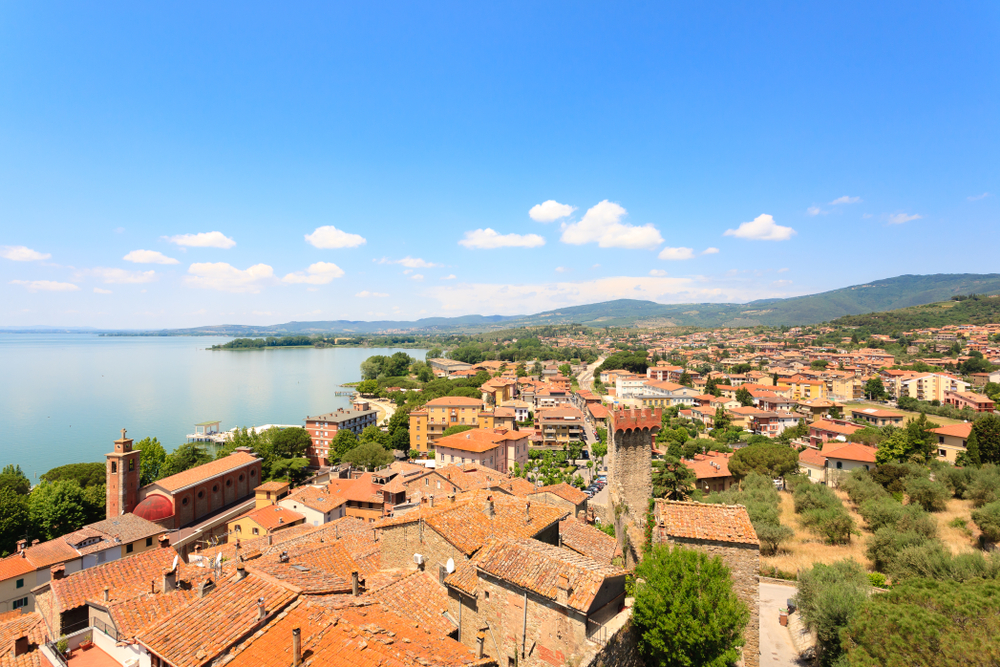
Notable buildings in the town include the castle (rocca) which was originally built by the Romans but which was rebuilt into the 5th and 6th centuries by the Longobards. There are also a number of religious buildings. These include the Pieve di San Cristoforo, built in 1000 AD and home to some beautiful frescoes, as well as the 16th century Sanctuary of the Madonna dell’ Oliveto. If you are visiting Passignano at the end of July, then watch out for the annual Palio delle Barche. This re-enacts the events of 1495 when the noble Baglioni and Oddi families fought a fierce battle here. The race involves all four districts of the town and around 160 competitors. It is fought in three stages. The first and last take place in the water but the middle stage actually takes place in the historic centre of the town. Competitors balance boats on their shoulders and race through the streets, echoing how the Oddi family had to flee from the castle back in the 15th century, boats on their shoulders. Alongside these races, the women compete in the ‘race of the pitchers’. Dressed in historical costumes with a pitcher of water on their heads, they race down the alley that would once have led from the public fountain to the castle gates. And, as you’d expect with any Italian festival, there will be plenty of food and other entertainment on offer during the week leading up to the main event.
TUORO SUL TRASIMENO is a hillside village that sits to the west of Passignano. It’s also the closest village to the historic battle between Hannibal’s army and the Romans.
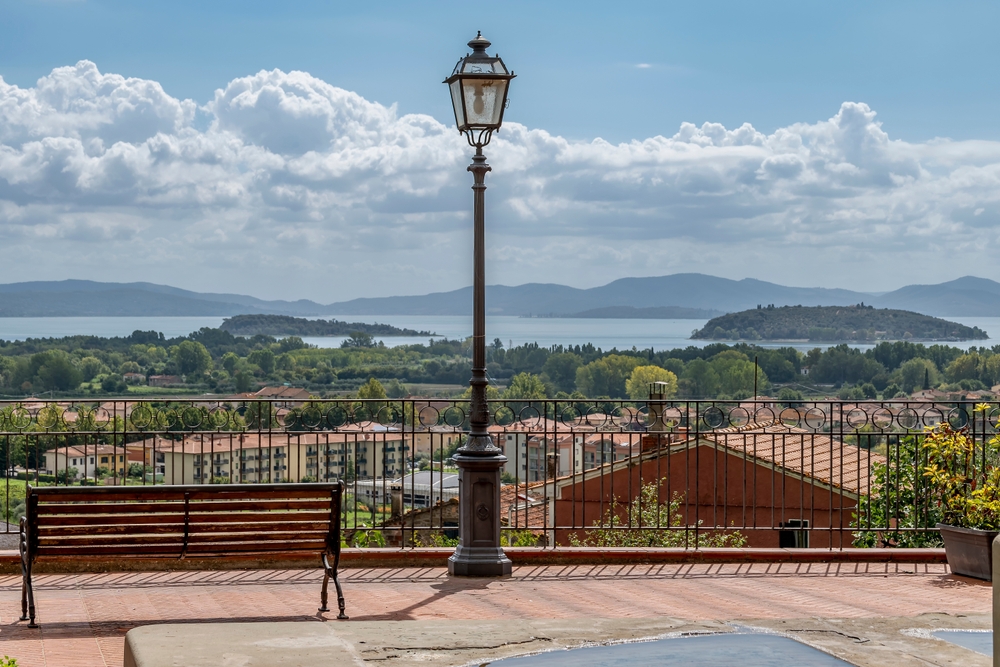
The historic centre of the village is home to the Palazzo del Capra. Built during the Renaissance period, it was built over the remains of Roman buildings where Gaius Flaminius supposedly died in battle and was interred. These days, it’s worth a visit to admire the frescoes by Perugino as well as to learn more about the history of this battle in the museum there. Also worthy of a visit is the 13th century Castello di Montegualandro which overlooks the town. Now a hotel, it’s possible to walk around the grounds even if you’re not a paying guest. Religious buildings of note include the Chiesa di Santa Maria Maddalena, the Pieve di Confine and the Chiese di Sant’ Agata. However, arguably, Tuoro sul Trasimeno is more famous for being close to one of Lake Trasimeno’s islands – Isola Maggiore – than for what is in the village itself. Certainly, the views of the islands from the village are wonderful. If you do head here, you may want to make an extra detour to visit Vernazzano. It’s where you will find a leaning tower far less well known than the one in Pisa but which has a rather impressive 13 degree lean!
CASTIGLIONE DEL LAGO sits on a promontory jutting into the lake. The Rocca del Leone dominates this walled town. Most of what you see today dates to the 16th century but its origins are rooted much further back in the 13th century, when it is believed to have been designed by the Franciscan monk, Frate Elias who may also have been responsible for the design of the Basilica of San Francesco in Assisi.
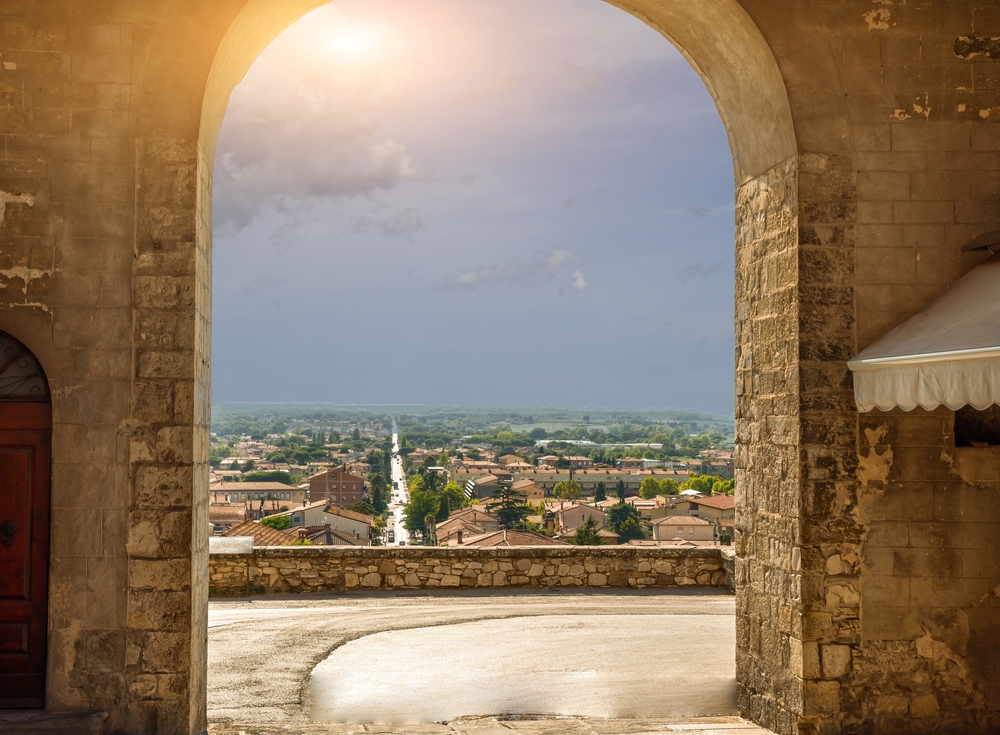
The Rocca is not the only architectural gem in Castiglione del Lago though. Also of note is the Palazzo della Corgna. A combined ticket will provide entry to both. The palace is situated in the Piazza Gramsci. Inside, you’ll find large rooms filled with fresco-covered ceilings. The third building of note in Castiglione del Lago is the 19th century Church of Santa Maria Maddalena. Built on the site of an earlier Medieval church, it contains frescoes by Pier Mariano Vittori and Alceste Ricci. Try and visit Castiglione del Lago at the end of April or beginning of May when the kite festival – Coloriamo i Cieli – takes place. This attracts thousands of kite flyers from all over the world along with numerous hot air balloons, both of which fill the skies above Castiglione del Lago with colour.
MAGIONE‘s most important building is the Castle of the Knights of Malta which dominates the town. Its large circular towers and courtyard and loggia are extremely striking. Also of note in Magione is the Church of San Giovanni Battista and the Torre dei Lombardi. The castle chapel boasts two 16th century frescoes attributed to the school of Pinturicchio whilst the Church contains a cycle of frescoes by Gerardo Dottori, a Futurist painter. Incidentally, art lovers will find more examples of his work in the Town Hall (Palazzo Comunale). If visiting Magione, make a small detour to Montecolognola to enjoy the exceptional views from here over the lake.
PANICALE is a charming town to the south of Lake Trasimeno. Start your visit in the central Piazza della Corte where you will find the beautiful Church of San Michele along with a 15th century fountain. The exterior of the Church may seem austere but the interior is an absolute gem of Renaissance art and architecture. From here, work your way through the cobbled streets to the top of the town and to the Palazza del Podestra. As you explore, look out for the 18th century Teatro Caporali and the Sanctuario di Mongiovino. And leave some time to pop into the Museo del Tulle. Once a church, it is now home to an impressive collection of lace.
Things to see and do on Lake Trasimeno
As well as visiting the wonderful towns and villages around Lake Trasimeno, there are a number of other activities you may want to enjoy. Lake Trasimeno is home to a number of well tended beaches. There are nine main beaches around the lake – three in Castiglione del Lago, two at Tuoro sul Trasimeno, three in Magione and one in Passignano. All have the option of hiring sun loungers and parasols and all have snack bars on site.
Lake Trasimeno is also a great option for sports lovers. The whole area is covered in walking and cycling paths. Seven kilometres north of Tuoro at the Passo di Gosparani, there are some excellent treks to be enjoyed along the old mule tracks up the Monte Castiglione. Alternatively, you can head up Monte Acuto from Galera or Monteacuto or up Monte Murlo from Preggio. Or if you’re looking for something a little less strenuous, there are a dozen marked trails around the lake from towns such as Magione, Castiglione del Lago, Panicale and Passignano. Just head to the local tourist information centres for maps of routes.
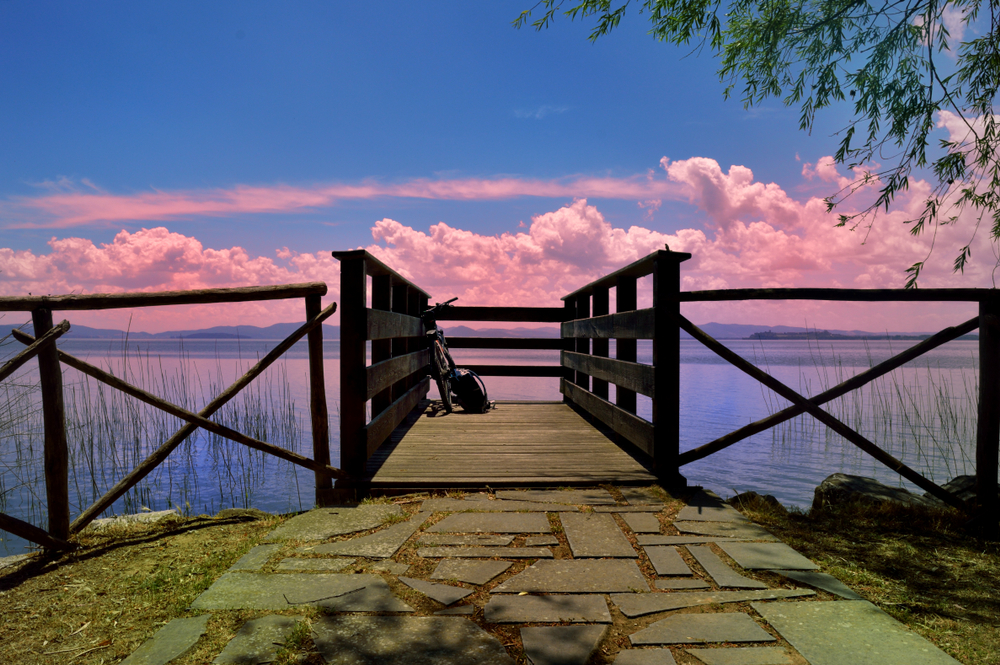
Other sporting activities are also on offer. In Passignano you can play tennis or enjoy some horse riding. Or, if you’re a keen golfer, then the Lamborghini Golf Club is also situated just to the south of the lake.
For those that prefer the water to being on land, then there are also a variety of water sports to be enjoyed on the lake including sailing, windsurfing, wakeboarding and even diving. SUP is also a popular pastime here. During the Summer months, the lake is covered with speed boats, yachts and windsurfers. Sailing lessons are available at the sailing schools in Castiglione del Lago, Passignano and Tuoro sul Trasimeno.
Another great way to spend the afternoon is to visit one of the wineries that are dotted in the hills around the lake.
The lake is rich in fish and it is possible to fish on the lake. Incidentally, to find out more about the history of fishing on Lake Trasimeno, head to the Fishing Museum in San Feliciano.
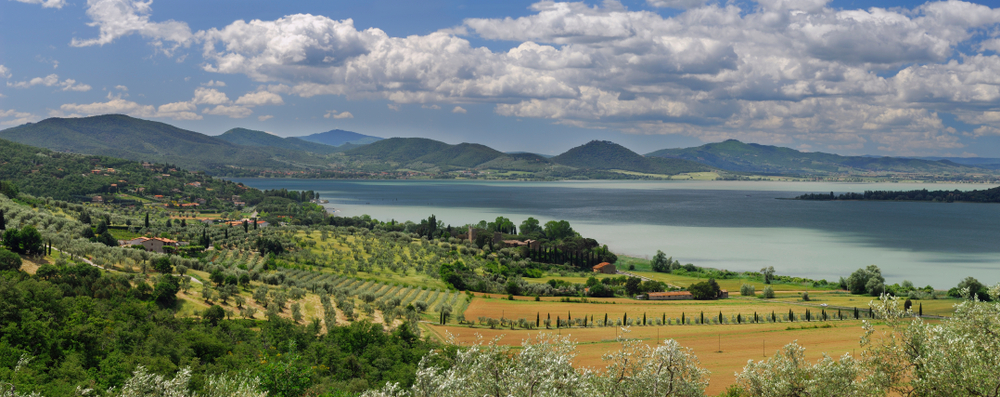
The lake is also home to three small islands, two of which – Isola Polvese and Isola Maggiore – can be visited by boat. The third island – Isola Minore – is privately owned and closed to the public. Boats run around 12 times per day throughout the year from Passignano to Isola Maggiore. It’s also possible to catch a boat from Castiglione del Lago to the island but there is a much reduced service on this route outside the main Summer season. To get to Isola Polvese, you can catch a boat from Passignano (once a day service) or from San Feliciano (around 8-9 services per day).
Isola Maggiore is still inhabited. It is home to a single village with around 100 residents. There are also three restaurants on the island if you fancy spending the day and enjoying a bite to eat. The island is traditionally known for its lace making. To find out more, visit the Museo del Merletto, home to some beautiful handmade lace. The island is also where you will find the Campo del Sole sculpture garden. There are 27 column sculptures in a permanent display here, all created in the 1980s. The other thing you can’t miss when visiting the island is the Castello Guglielmi and the 13th century Pieve di San Michele Arcangelo which was once the main church for those living on the island. It’s a lovely walk through olive groves to reach this. To get a good feel for the whole island, you can also opt to take a stroll around the 2 km long perimeter path. Take this route and you will pass the circular Medieval tower which stands watch at the shoreline. Another walk can be enjoyed from the landing stage to the 12th century Church of San Salvatore.
Events on Lake Trasimeno
Lake Trasimeno plays host to a number of events. Some of these have already been mentioned but others include the Trasimeno Music Festival and Trasimeno Blues. There are also literary events and, of course, plenty of events that revolve around food too!
Where to stay on Lake Trasimeno
If you’re looking to visit Lake Trasimeno, then Villa Cortona is the perfect base. It’s just a 15 minute drive from Cortona to Lake Trasimeno. Beautifully restored, the interior is immaculately presented whilst outside the house is set in stunning gardens surrounded by olive groves and with a large private pool and terrace to enjoy.
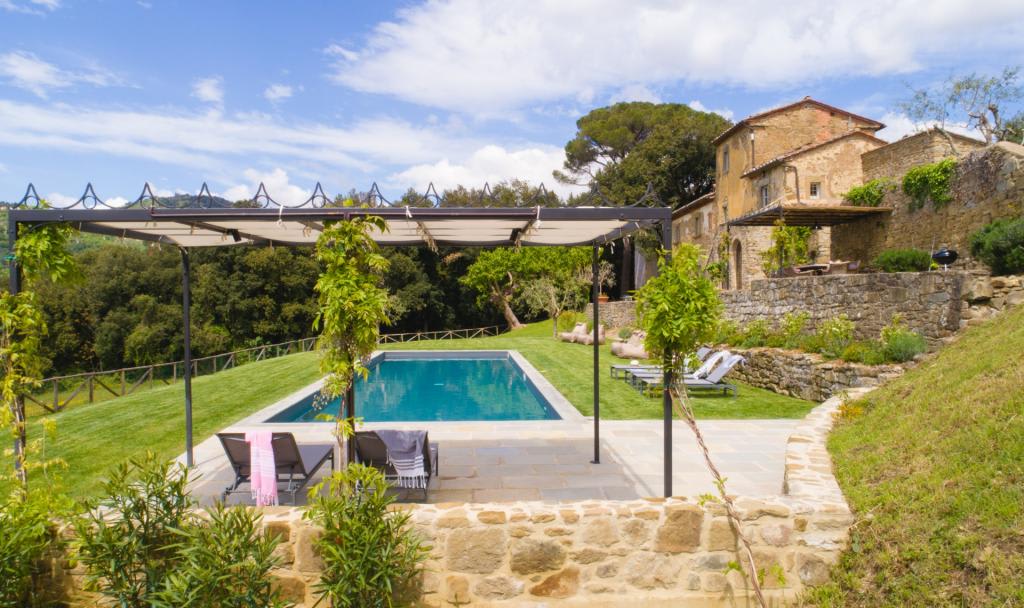
Another great option if you’re looking to visit Lake Trasimeno is to opt for one of the Umbria apartments and Umbria villas that Bookings For You has in Paciano. Again, it’s just a 15 minute drive from here to Lake Trasimeno and, with a range of villas and apartments with everything from one to five bedrooms, there is something for every group size.
